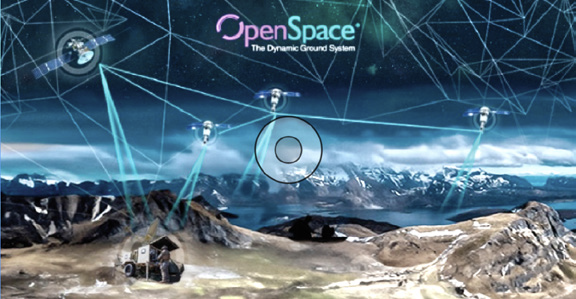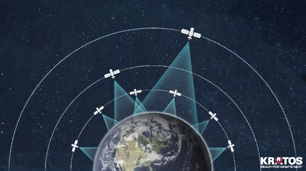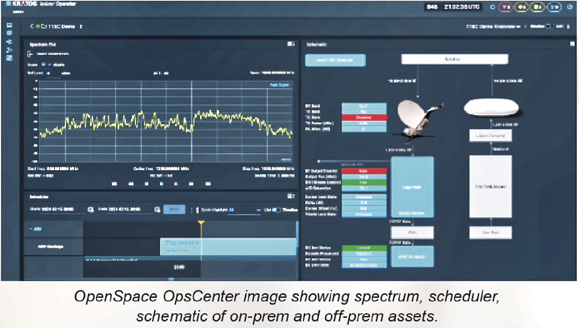Consider a road network and the options available to deliver a time-sensitive package to a destination. To get there, you may use a combination of routes to avoid accidents, road work and rush hour.

Likewise, the military is exploring traffic routes across various satellites orbits, as a way to contend with space network traffic jams, whose ramifications could be significantly more dire.
Multi-Orbit
Functionality
Unlocked
In a series of recent demonstrations for military and commercial entities, Kratos showed how the company’s fully software-defined OpenSpace Platform supports seamless integration between commercial and military satellite networks at LEO, MEO and GEO. Collaborating with other satellite operators and equipment partners, Kratos successfully tested and verified functionality of OpenSpace as a gateway and edge platform at each of the major orbital belts.
Seamless MEO
Using Virtualized
SATCOM
Kratos and SES, a leader in global content connectivity solutions, successfully executed a fully virtualized SATCOM ground system demonstration for the U.S. Army’s Combat Capabilities Development Command.
In an industry first, the demonstration showed seamless operation supporting satellites in Medium Earth Orbit (MEO) on a “make-before-break” mode over SES’s O3b MEO satellite network. Make-before-break is an essential capability for MEO and LEO satellite constellations referring to the ability to transfer communication sessions while the user transverses the coverage areas of different satellites.
Leveraging the Advantages of Each Orbit
• Low-Earth Orbit (LEO) satellites offer low latency, ideal for real- time data exchange and rapid decision-making.
• High-Throughput Geostationary (GEO) satellites provide persistent, wide area coverage and high bandwidth for data-intensive applications.
• Medium-Earth Orbit (MEO) offer a balance of both, they have more coverage and handle more data than LEO and provide lower latency than GEO.
Flexible +
Diverse
Operations
The demonstration employed a remote terminal in Port St. Lucie, U.S., and a gateway in Lima, Peru, which connected to a software-defined Kratos OpenSpace® vStar hub system located more than 3,000 miles away in Virginia, U.S., all orchestrated and conducted over SES’s O3b satellite network.
Going forward, military missions will require flexible communication routes based on multiple satellites, networks and network elements. Only a software-defined satellite ground platform will provide levels of adaptability at mission speed along with the openness to maximize available network resources.
Dynamic LEO
Using Virtualized
SATCOM
Similarly for the U.S. Army’s Combat Capabilities Development Command, Kratos and demonstration partners Telesat Government Solutions and Cobham Satcom, demonstrated a fully virtualized SATCOM ground system, showing dynamic support of simultaneous communication pathways for resilient SATCOM at LEO.
The demonstration showed a flexible network architecture that allowed soldiers to connect Telesat’s LEO 3 satellite through Cobham antennas. Kratos’ OpenEdge™ 2500 digitizer was integrated with Cobham’s Tracker 1300TT antenna, enabling standardized traffic (DIFI) to pass directly from Cobham’s digital-ready antenna through virtualized modems at the network’s edge to the LEO 3 satellite.

The more resilient a strategic communication network is to disruptions — enemy jamming, disconnected environments, or limited bandwidth — the greater its effectiveness.
The OpenEdge 2500 is a digitizer that converts radio frequency (RF) signals into Internet protocol (IP) data streams to help satellite antenna manufacturers digitally enable their products. The OpenEdge 2500 can enable digital IF (DIFI) within almost any parabolic, electronically steerable, or flat panel antenna.
By using a variety of transport pathways across different orbits, such as MEO and LEO, communication becomes more diverse and adaptable. This type of networkmakes it harder for adversaries to completely disrupt or deny access. These demonstrations showed that, regardless of the orbit, Kratos OpenSpace can offer a variety of software-defined form factors to existing ground segments (both gateway and edge) including on-prem, off-prem or a hybrid variation.

What is the difference between orbits? The answer:
Speed + Performance
Unlike traditional SATCOM equipment that are limited to Geosynchronous Earth Orbit (GEO) satellites, a multi-orbit approach provides a redundant, robust communication backbone, ensuring critical information flows even in the face of adversity.
The single most important aspect of each of these demonstrations was the versatility and adaptability of OpenSpace as a ground segment system.
The gateways themselves could be moved from cloud to hardware, as needed, and the digitizers could be collocated to the gateway or remotely located at a teleport.
Multi-beam,
Multi-orbit
Mission
Operations
Recently, Kratos also revealed ongoing progress in successfully supporting a large military program, using the OpenSpace virtualized SATCOM ground system as part of a milestone demonstration that will provide the backbone for multi-beam, multi-orbit space operations.

This capability will allow the military to instantiate new services in minutes instead of the weeks, or even months, commonly required with traditional hardware-based ground systems.
In all three cases, Kratos showed a flexible network architecture facilitating simultaneous communication pathways for resilient SATCOM with a virtualized and containerized architecture enabling soldiers to position their radio frequency (RF) hardware and software-defined hubs anywhere across the globe.
The Road to Multi-
Orbit Connectivity is
Built with Software
SATCOM
Kratos’ OpenSpace platform revolutionizes satellite communication by enabling seamless, multi-orbit connectivity through software-defined orchestration. By breaking free from traditional hardware limitations, OpenSpace unlocks the full potential of ever-evolving commercial satellite networks, paving the way for a future of dynamic, resilient and adaptable ground infrastructure.
www.kratosdefense.com

Chris Badgett
Chris Badgett is the Vice President of Technology for Kratos Space. He has been instrumental in designing the capability for the military to take advantage of virtual ground solutions and the ability to securely leverage the power of cloud computing and global antenna networks. Prior to Kratos, Mr. Badgett served in the Air Force Research Lab and Space and Missile System Center enabling technologies for UAVs, datalinks, small satellites and ground systems. Mr. Badgett holds a BS in Electrical Engineering from University of Tennessee and an MS in Space Systems from the Air Institute of Technology.


